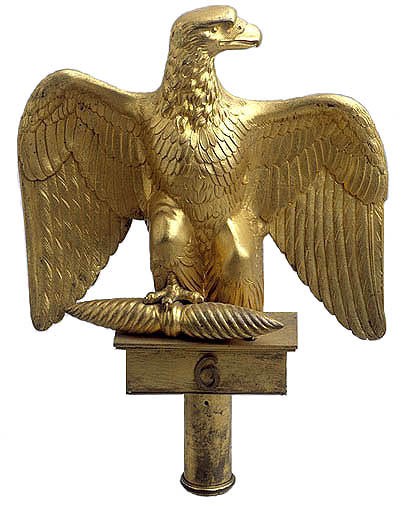A traditional heraldic symbol, the eagle was adopted in the decree of 10 July, 1804, which stipulated that the seal and arms of the Empire should be: “azure with an antique-style eagle in gold bearing a thunderbolt in its claws, also gold“. Associated since the earliest antiquity with military victory, the eagle, the bird of Jupiter (King of the Olympian gods) was the symbol of Imperial Rome. It was also that of the First French Empire. Just like on Roman standards, a bronze eagle was placed at the top of the staff bearing the regimental colours. The distribution of these 'aigles', as they became known, took place during an imposing ceremony on the Champ-de-Mars, 5 December, 1804, three days after the coronation of Napoleon. At this presentation on the Champs-de-Mars, Napoleon spoke as follows: “Soldiers, here are your colours! These 'eagles' will always serve you as a rallying point; they will be sent wherever the emperor thinks fit in the defence of his throne and his people. You have sworn to sacrifice your lives to protect them and to keep them always, through your courage, on the road to victory“.
Cast in bronze by Thomire following a design by Chaudet, colour eagles had their heads turned to the right, their wings were spread slightly, and they carried in their claws one of Jupiter's thunderbolts. The eagle istself was set upon a small box bearing the number of the regiment, through which passed a dowel which fixed the eagle to the flagstaff. Three models were made during the Empire. The first, the 1804 model, is the most remarkable because of it general style and the quality of the chasing. For the second version, the 1810-1811 model (characterised as «light»), Thomire reduced the reputedly excesive weight of the 1804 model. Finally, there was the version known as the Cent-Jours model, made to replace those which had been destroyed during the First Restoration. The work on these eagles is less detailed since they were made in a hurry. Other differences with respect to the earlier models were: a more gathered in position, shorter wings, and the beak almost closed. The numbers on the boxes were those of the earlier eagles kept by the founder who had been ordered to destroy them and given to Napoleon on his return to Paris.
The model here is of this third, 'Cent-Jours', type. It belonged to the 6e Regiment de Chasseurs à Cheval. Whilst many were destroyed after the fall of the Empire, this model was saved by Colonel de Faudoas (1788-1844) who served in the Armée du Nord in Belgium and who fought at Waterloo.
Karine Huguenaud (tr. P.H.)
September 2003
The Cent-Jours standard Eagle of the 6e Régiment des Chasseurs à Cheval

- Date :
- 1815
- Technique :
- gilt bronze
- Dimensions :
- H = 30 cm
- Place held :
- Fondation Napoléon, donation Lapeyre
- Photo credit :
- © Fondation Napoléon - P. Maurin-Berthier

